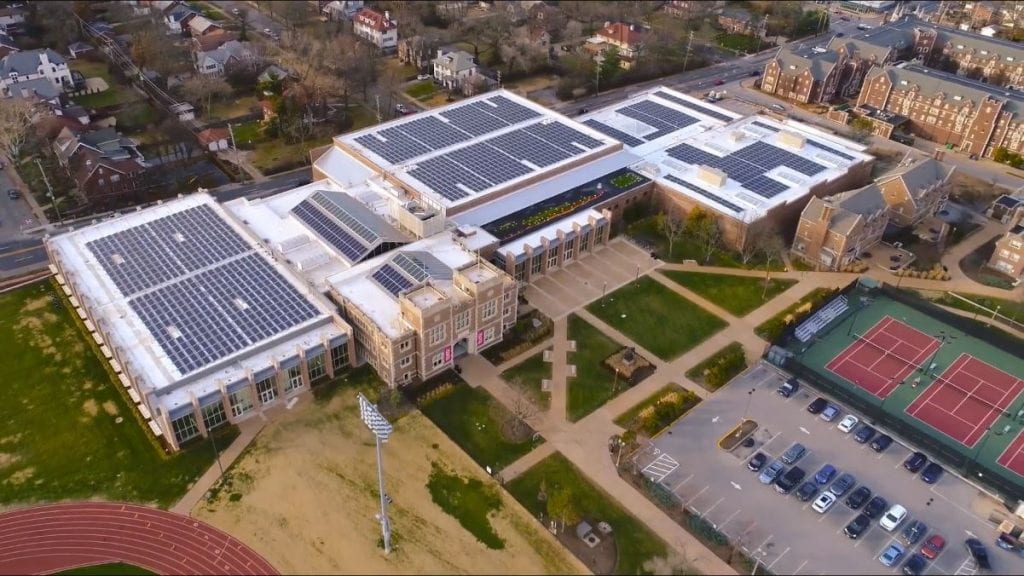Now more than ever, the climate crisis is on the minds of people all around the world. Due to the urgent need to implement effective solutions to this social and environmental crisis, we will be regularly featuring stories of climate solutions adopted at the university and at the local, state, and national levels to inspire and accelerate positive change.
As we previously announced, St. Louis was only the fourth jurisdiction in the nation and the first in the Midwest to adopt a building energy performance standard (BEPS) policy, following similar policies in New York City, Washington, D.C., and Washington State. Earlier this month, the City of St. Louis achieved a significant milestone when it announced the new BEPS targets that building owners will be required to meet in the coming years. The BEPS policy and the targets themselves are aimed at accelerating energy efficiency and emissions reductions in the City of St. Louis, where buildings account for 65% of greenhouse gas emissions, according to the City’s 2018 GHG inventory. The new targets vary by property type and were set by a Building Energy Improvement Board made up of local representatives from the commercial building sector, affordable housing, and other stakeholder groups.
Claire Santoro, a staff member in the Washington University Office of Sustainability, provided critical data analysis and data visualization expertise throughout the process of setting the targets. Based on Claire’s analysis of local energy benchmarking data and national datasets, St. Louis buildings are considerably more inefficient than the national median. This means the opportunity for cost-effective climate action in our region is even greater. The inefficiency of St. Louis buildings represents tremendous opportunity to reduce emissions, save money, create jobs, and protect public health.
What is a BEPS?
A BEPS policy sets building energy efficiency targets for all new and existing buildings in a specific geographic area. Buildings that do not meet the performance target will have to invest in energy efficiency improvements in the coming years to drive down their energy use and emissions. The St. Louis BEPS policy applies to large buildings over 50,000 square feet, which includes many buildings on WashU campuses. The St. Louis BEPS policy specifies that increasingly stringent standards will be set by the Building Energy Improvement Board every four years. All buildings covered by the BEPS policy have already been required to report their annual energy use to the City of St. Louis since 2017 as part of the City’s Building Energy Awareness Ordinance.
You can find additional information on the City’s BEPS policy here: Climate Solutions: St. Louis Leads Midwest with New Building Energy Performance Standard
Next Steps
The first BEPS compliance cycle is expected to begin later this year after the City concludes its rulemaking process. After that, most buildings will have four years to meet their performance targets. Building owners can meet the targets through a broad range of energy efficiency measures, most of which will pay for themselves in a short amount of time, including heating and cooling system upgrades, LED lighting retrofits, new control systems that adjust building schedules and thermostat settings to save energy when buildings are unoccupied, and more. Buildings that are unable to meet the target by the end of the compliance period will be able to work with the Building Division and the Building Energy Improvement Board to develop alternative compliance methods that will achieve meaningful energy efficiency improvements.
That means that, for now, the City’s work on detailing compliance pathways continues. Following finalization of the new standards on May 4, Rajiv Ravulapati, Government Services Analyst for the City of St. Louis Building Division, said: “The City of St. Louis reached a new milestone today with its adoption of final energy performance targets for its BEPS ordinance. We are grateful to work with our Building Energy Improvement Board members to help advise on BEPS targets, but there is still much work to be done. We are excited to show the country that St. Louis is a future leader in building efficiency policies and climate work.” As the rulemaking process continues this year, the Building Division will provide more detail on compliance pathways and helpful resources in order to work with local building owners.
A Continuing Partnership
Since the fall of 2019, staff from the WashU Office of Sustainability – with support from a grant from Bloomberg Philanthropies – have been working closely with the City of St. Louis to develop a strategy to set ambitious-yet-achievable BEPS targets based on local building energy benchmarking data. Although those targets have now been finalized, WashU will continue to support the City in its efforts as part of the university’s larger commitment to accelerating regional climate action. This collaborative, cross-sector approach inspired much of WashU’s programming at the 2020 Midwest Climate Summit and will be the foundation of several new initiatives to launch later this year—stay tuned!
